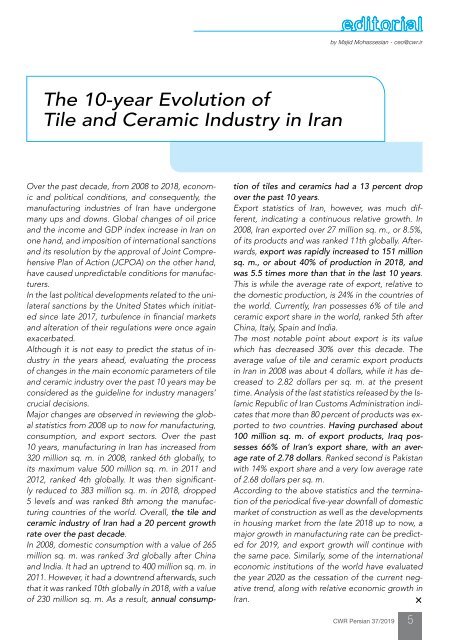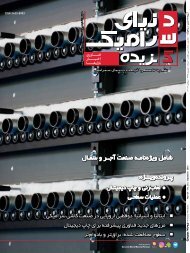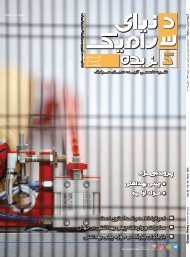Create successful ePaper yourself
Turn your PDF publications into a flip-book with our unique Google optimized e-Paper software.
editorial<br />
by Majid Mohassesian - ceo@cwr.ir<br />
The 10-year Evolution of<br />
Tile and Ceramic Industry in Iran<br />
Over the past decade, from 2008 to 2018, economic<br />
and political conditions, and consequently, the<br />
manufacturing industries of Iran have undergone<br />
many ups and downs. Global changes of oil price<br />
and the income and GDP index increase in Iran on<br />
one hand, and imposition of international sanctions<br />
and its resolution by the approval of Joint Comprehensive<br />
Plan of Action (JCPOA) on the other hand,<br />
have caused unpredictable conditions for manufacturers.<br />
In the last political developments related to the unilateral<br />
sanctions by the United States which initiated<br />
since late 2017, turbulence in financial markets<br />
and alteration of their regulations were once again<br />
exacerbated.<br />
Although it is not easy to predict the status of industry<br />
in the years ahead, evaluating the process<br />
of changes in the main economic parameters of tile<br />
and ceramic industry over the past 10 years may be<br />
considered as the guideline for industry managers’<br />
crucial decisions.<br />
Major changes are observed in reviewing the global<br />
statistics from 2008 up to now for manufacturing,<br />
consumption, and export sectors. Over the past<br />
10 years, manufacturing in Iran has increased from<br />
320 million sq. m. in 2008, ranked 6th globally, to<br />
its maximum value 500 million sq. m. in 2011 and<br />
2012, ranked 4th globally. It was then significantly<br />
reduced to 383 million sq. m. in 2018, dropped<br />
5 levels and was ranked 8th among the manufacturing<br />
countries of the world. Overall, the tile and<br />
ceramic industry of Iran had a 20 percent growth<br />
rate over the past decade.<br />
In 2008, domestic consumption with a value of 265<br />
million sq. m. was ranked 3rd globally after China<br />
and India. It had an uptrend to 400 million sq. m. in<br />
2011. However, it had a downtrend afterwards, such<br />
that it was ranked 10th globally in 2018, with a value<br />
of 230 million sq. m. As a result, annual consumption<br />
of tiles and ceramics had a 13 percent drop<br />
over the past 10 years.<br />
Export statistics of Iran, however, was much different,<br />
indicating a continuous relative growth. In<br />
2008, Iran exported over 27 million sq. m., or 8.5%,<br />
of its products and was ranked 11th globally. Afterwards,<br />
export was rapidly increased to 151 million<br />
sq. m., or about 40% of production in 2018, and<br />
was 5.5 times more than that in the last 10 years.<br />
This is while the average rate of export, relative to<br />
the domestic production, is 24% in the countries of<br />
the world. Currently, Iran possesses 6% of tile and<br />
ceramic export share in the world, ranked 5th after<br />
China, Italy, Spain and India.<br />
The most notable point about export is its value<br />
which has decreased 30% over this decade. The<br />
average value of tile and ceramic export products<br />
in Iran in 2008 was about 4 dollars, while it has decreased<br />
to 2.82 dollars per sq. m. at the present<br />
time. Analysis of the last statistics released by the Islamic<br />
Republic of Iran Customs Administration indicates<br />
that more than 80 percent of products was exported<br />
to two countries. Having purchased about<br />
100 million sq. m. of export products, Iraq possesses<br />
66% of Iran’s export share, with an average<br />
rate of 2.78 dollars. Ranked second is Pakistan<br />
with 14% export share and a very low average rate<br />
of 2.68 dollars per sq. m.<br />
According to the above statistics and the termination<br />
of the periodical five-year downfall of domestic<br />
market of construction as well as the developments<br />
in housing market from the late 2018 up to now, a<br />
major growth in manufacturing rate can be predicted<br />
for <strong>2019</strong>, and export growth will continue with<br />
the same pace. Similarly, some of the international<br />
economic institutions of the world have evaluated<br />
the year 2020 as the cessation of the current negative<br />
trend, along with relative economic growth in<br />
Iran. ×<br />
<strong>CWR</strong> <strong>Persian</strong> <strong>37</strong>/<strong>2019</strong> 5




